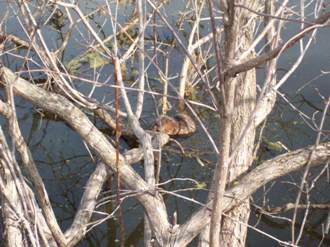
Nutrition:
You are what you eat
Muskrats are a very
versatile species when it comes to their diet. Muskrats
are mainly herbivores, but under certain circumstances
they may
choose to feed on animals. They feed on many different plant
species including:
Cattail, River Bulrush, Various Sedges,
Duckweeds, Arrowhead, Bur Weed, Smartweed, Sweetflag, Reeds,
Water Lilies, Wild Rice, Pickerelweed, Clover, Willow, Acorns,
Switchgrass, and Long-Leaf
Pondweed. While some of these
plant species are specific to the muskrat’s habitat, they are
not limiting to a muskrat’s diet. Muskrats will feed on almost
all edible plant species that are in or very near the habitat
they are living in, especially if the population is large for
the habitat they are occupying. Habitats near agricultural
land, such as corn fields, can also provide a food source for
muskrats. However, they will usually only resort to
feeding on land if the vegetation in their aquatic environment
is becoming hard to find. Muskrats feeding in aquatic
environments will usually eat the tender parts of plants near
the base of the plant first, and then also feed on the roots and
leaves. Circumstances in which a population of muskrats is
overpopulating an area or where food is scarce due to natural
causes, muskrats will feed on animals. These animals tend
to include:
mussels, frogs,
snails, fish,
carrion,
turtles, and clams.

The time
of year can also have an influence on what the muskrats eat.
In the spring, summer and fall seasons, many different plants and
food sources are heavily available for the muskrats. Once
winter falls upon the muskrat’s habitat though, food sources can
become very limited. This is due to several factors; the
plants that typically make up the muskrat’s diet do not grow during
the winter months, and the ice also can prevent muskrats from
foraging above water. Due to these reasons, during the winter
densely grown submergent vegetation such as cattails and river
bulrush are a main part of the muskrat’s diet. This is because
these types of plants are available for ingestion throughout the
year, and the
rhizomes on these plants also have a very high nutritious value
which can sustain the muskrats until new vegetation begins to grow
in the spring.
When
thinking about a muskrat’s diet, another factor to consider is the
location of their habitat. Muskrats
can inhabit a variety of habitats including: marshes, ponds, lakes,
reservoirs, canals, and streams. For example, muskrats living
in lakes, ponds, and reservoirs are usually more carnivorous than
muskrats living in marshes and streams that are mostly herbivorous.
Click here to go to
the Life History/Reproduction page!
Click here to go home!